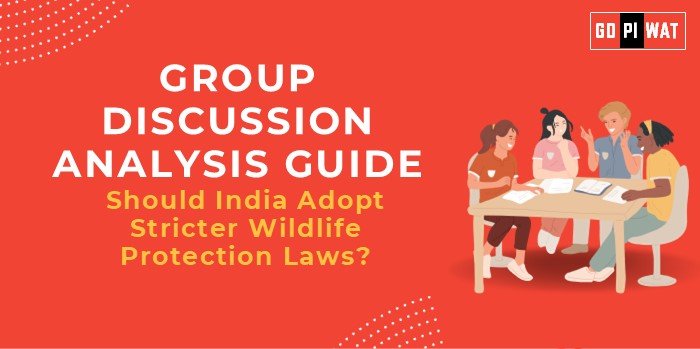📋 Group Discussion Analysis Guide: Should India Adopt Stricter Wildlife Protection Laws?
💡 Introduction to the Topic
- 📖 Opening Context: “India, home to 7-8% of all recorded species globally, faces growing challenges in protecting its unique biodiversity. Stricter wildlife protection laws could offer critical solutions to combat poaching, habitat loss, and human-wildlife conflict.”
- 📜 Topic Background: India’s Wildlife Protection Act, 1972, is a key framework for conserving its rich biodiversity. However, increasing incidents of poaching, illegal trade, and environmental degradation demand a reassessment of the legislative framework. Recent reports on declining tiger and elephant populations highlight the urgency for stricter laws.
📊 Quick Facts and Key Statistics
- 🌱 India’s Biodiversity: Over 90,000 animal species and 47,000 plant species, contributing significantly to global biodiversity.
- 🦁 Poaching Losses: 1,088 tiger deaths since 2012, with poaching accounting for nearly 20%.
- 🌍 Illegal Wildlife Trade: Valued at $20 billion globally; India is a critical hub.
- 🛡️ Protected Areas: 106 national parks and 565 wildlife sanctuaries cover 5% of India’s landmass.
- 🐘 Human-Wildlife Conflict: Over 500 deaths annually due to elephant encounters alone (Wildlife Institute of India, 2023).
🌟 Stakeholders and Their Roles
- 🏛️ Government Agencies: Enforce wildlife laws and manage protected areas.
- 🌿 Non-Governmental Organizations (NGOs): Drive awareness campaigns, research, and policy advocacy.
- 👥 Local Communities: Critical participants in conservation and victims of human-wildlife conflict.
- 🌍 International Organizations: Collaborate on global agreements like CITES (Convention on International Trade in Endangered Species).
📈 Achievements and Challenges
🏆 Achievements
- ✅ Project Tiger: Tiger population grew from 1,411 in 2006 to 3,167 in 2022.
- ✅ Project Elephant: Focused on habitat protection and reducing conflict, saving elephant corridors.
- ✅ Protected Area Expansion: Doubling of conservation zones since the 1990s.
⚠️ Challenges
- 🚧 Weak Enforcement: Inefficient implementation of laws leads to poaching and trade.
- 🚧 Community Impact: Livelihood loss for forest-dependent populations due to restrictive policies.
- 🚧 Global Comparisons: South Africa’s advanced anti-poaching technologies and funding models show better outcomes.
📜 Case Study
🌱 Maharashtra’s Tadoba Tiger Reserve: Its eco-tourism model has benefited local livelihoods while protecting biodiversity.
🗣️ Structured Arguments for Discussion
- 👍 Supporting Stance: “Stricter wildlife laws are essential to prevent biodiversity loss and uphold global conservation commitments.”
- 👎 Opposing Stance: “Tighter regulations may alienate local communities, increasing conflict and undermining conservation efforts.”
- ⚖️ Balanced Perspective: “While stricter laws are necessary, they must be paired with community inclusion and technological advancements for effective outcomes.”
💬 Effective Discussion Approaches
- 📈 Opening Approaches:
- Statistical Impact: “India hosts 75% of the world’s wild tiger population but lost over 100 tigers annually to poaching in the last decade.”
- Global Benchmarking: “South Africa’s anti-poaching drones cut poaching incidents by 40%; can India replicate this success?”
- ⚡ Counter-Argument Handling:
- Highlight balanced solutions, e.g., “Introducing community incentives while enforcing stricter penalties could resolve opposition.”
📋 Strategic Analysis of Strengths and Weaknesses
- 💪 Strengths: Rich biodiversity, global conservation leadership potential.
- ⚡ Weaknesses: Weak law enforcement, human-wildlife conflict.
- 🌟 Opportunities: Eco-tourism, international funding, and tech integration.
- ⚠️ Threats: Habitat encroachment, climate change impact.
📚 Connecting with B-School Applications
- 🌏 Real-World Applications: Conservation financing, sustainable tourism business models.
- 📋 Sample Interview Questions:
- “What role can technology play in wildlife law enforcement?”
- “Discuss India’s performance in global biodiversity rankings.”
- 💡 Insights for B-School Students: Explore case studies linking wildlife laws to economic models, policy drafting, and CSR opportunities.


